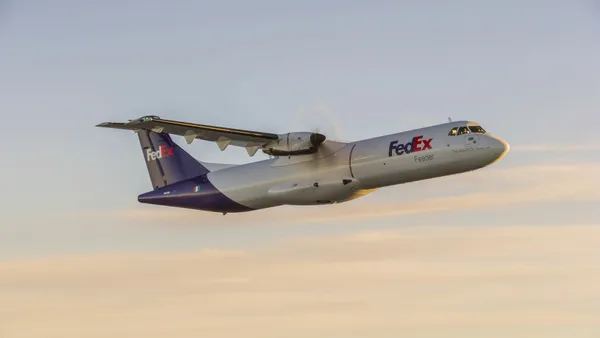Dive Brief:
- Using electric, autonomous drones for package deliveries can result in "operational costs [that] are at least 70% lower than a van delivery service," Pedro Pacheco, a senior director analyst at Gartner, said in a company research note published Tuesday.
- These cost savings come from avoiding traffic. Drones can cover greater distances in shorter amounts of time, thereby saving fuel, cutting costs-per-mile and reducing their carbon footprint, Pacheco said.
- Some experts disagree about the energy efficiency of drone fleets. A Rand report from 2017, and a January study conducted by researchers from Martin Luther University in Germany, found using drone fleets could use roughly the same or up to 10 times more energy, respectively, than traditional van deliveries, when run at scale.
Dive Insight:
Gartner estimates 1 million drones will be running retail deliveries by 2026, compared to 20,000 today.
Currently, DHL, FedEx, UPS and other major carriers have drone delivery operations up and running. While the scale of these deliveries remains limited to pilot operations in certain areas largely due to regulatory constraints, Gartner experts anticipate those roadblocks will be largely overcome by 2025, paving the way for full-scale operations.
But to reach that target within the next six years, companies will need to start investing now, acquiring the drones and establishing the digital infrastructure to operate them, according to the company's note.
In addition, determining which parcels are best carried by drones (drones have lower weight limits) versus conventional trucks requires a careful examination of a shipper's delivery network.
For firms looking to drones as a way to reap fuel savings over time, the math begins to get more complicated.
Rand conducted a study using UPS parcel delivery data from Minneapolis in 2017, anticipating a hybrid logistics model whereby electric drones would deliver lighter-weight parcels, and traditional last-mile trucks would handle larger, more difficult deliveries.
The report found drones would end up taking over roughly 20% of the deliveries, requiring 13 fewer trucks and resulting in a net fuel savings of about 5.7%.
"Shifting some deliveries to drones would not have a major impact on the energy intensity of package delivery," the report found. "However, it would shift this energy from diesel-burning trucks to electric drones, which might have a beneficial impact on the carbon footprint of package delivery until the delivery truck fleet can be converted to lower-carbon footprint."
Gartner attributes its 70% figure to savings on labor and vehicle maintenance costs from using drones versus vans. "The most critical factor is the number of deliveries that can be made on a single route," Bill Ray, a senior research director at Gartner, told Supply Chain Dive via email. "A van delivering 100 parcels to the same tower block is enormously efficient, while the same van delivering 100 parcels across a city can be replaced with drones to reduce costs."
However, there are additional factors in drone delivery, particularly wind speeds, that can drastically affect their energy efficiency. The study from Martin Luther University found that drones' "energy demands are about 3–10 times higher than the energy demands of [electric delivery vehicles]," in medium to high wind-speed conditions.
In most scenarios involving a high number of delivery stops (such as would be required in city settings) drones performed on par or worse than electric or diesel delivery vehicles in terms of fuel efficiency, according to the study.
“Parcel carriers, for example, can stop and deliver several parcels on foot if multiple customers are receiving deliveries in one street. This is not possible for drones, as they can only deliver one package at a time. This increases their energy consumption, sometimes drastically,” Thomas Kirschstein, head researcher on the Martin Luther University study, told Engineering and Technology.
However, in rural settings with fewer customers and greater distances required, drones could prove the more energy efficient option, according to the Martin Luther University research.
The studies from Rand and Martin Luther University agreed that if the goal is to reduce a logistics operation's carbon footprint, using drones was a good option. Electricity can be drawn from renewable sources, and using them for less intensive deliveries could help shippers transition to being more environmentally friendly as they electrify their trucking fleets, the studies found.
This story was updated with commentary from Gartner.













